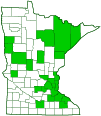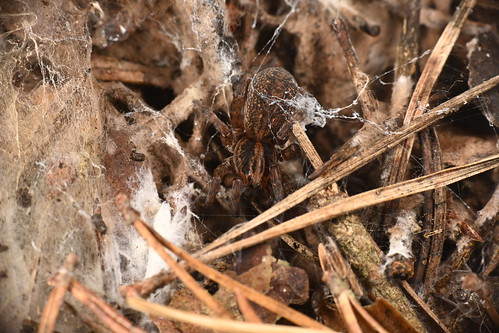ground wolf spider
(Trochosa terricola)
Conservation • Description • Habitat • Biology • Distribution • Taxonomy
Conservation Status |
|
|||||||
| IUCN Red List | not listed |
|||||||
| NatureServe | NNR - Unranked |
|||||||
| Minnesota | not listed |
|||||||
Description |
||
Ground wolf spider is a medium-sized, thick-bodied, short-legged, wolf spider. It occurs in temperate areas of the Northern Hemisphere, mostly in Europe and North America. It is common in Minnesota. It is found in deciduous woodlands and shady fields, mostly at woodland edges, on the ground in leaf litter and under logs and stones. Females are 5⁄16″ to ½″ (8.2 to 11.8 mm) in length and have a ⅝″ to 13⁄16″ (15 to 30 mm) legspan. Males are smaller, ¼″ to ⅜″ (6.7 to 9.6 mm) in length. The front part of the body (cephalothorax) is longer than wide. The upper side (carapace) of the cephalothorax is low, has a depression in the middle (fovea). It is relatively flat when viewed from the side, about the same height from the second (posterior) row of eyes to the rear. It is dark orangish-brown with a broad pale stripe in the middle and on each side a pale submarginal band. Within the median band there is a pair of short, dark, longitudinal streaks extending from behind the posterior row of eyes to the fovea. The presence of these stripes distinguishes this wolf spider as belonging to the genus Trochosa. There are eight eyes in two rows of four. The front (anterior) row has four small eyes and is straight or slightly curved forward. The rear (posterior) row has two very large posterior median eyes (PME) and two large posterior lateral eyes (PLE). The PLE are set behind the PME, and some authors describe this arrangement as three rows of eyes. The rear row is about equal in width to the middle row. The PME are closer to the PLE than to each other. The PME and PLE have a layer of reflective tissue internally. This allows the spider to see in relative darkness. It also causes their eyes to shine when hit by the beam of a flashlight. The basal segments of the jaws (chelicerae) are large and powerful. The forward-facing margin has three teeth, the rear-facing margin has two or three teeth. The abdomen is egg-shaped and is covered with short hairs. It is yellowish-orange at the base with extensive dark mottling. On the front half there is a pale oval mark (cardiac mark) in the middle that is partially outlined with dark brown. The legs are short, stout, spiny, and sparsely hairy. They are pale yellowish-brown and mottled with dark brown but are not banded. The ends of the fifth segment (tibia), sixth segment (metatarsus), and seventh segment (tarsus) are brown. |
||
Size |
||
Female Body Length: 5⁄16″ to ½″ (8.2 to 11.8 mm) Male Body Length: ¼″ to ⅜″ (6.7 to 9.6 mm) Legspan: ⅝″ to 13⁄16″ (15 to 30 mm) |
||
Web |
||
None |
||
Similar Species |
||
Habitat |
||
Deciduous woodlands and shady fields, mostly at woodland edges, on the ground in leaf litter and under logs and stones |
||
Biology |
||
Season |
||
March to November |
||
Behavior |
||
|
||
Life Cycle |
||
Mating takes place in the spring. Adults mature in the fall. |
||
Food |
||
|
||
Distribution |
||||
|
Sources Nearctic species of the wolf spider genus Trochosa (Araneae: Lycosidae) Allen Brady. 1980. Psyche, Cambridge 86:167-212.
|
|||
| 5/27/2022 | ||||
Occurrence |
||||
Common in Minnesota |
||||
Taxonomy |
|||
| Class | Arachnida (arachnids) | ||
Order |
Araneae (spiders) | ||
Suborder |
Araneomorphae (typical spiders) | ||
| Infraorder | Entelegynae | ||
Zoosection |
RTA clade spiders |
||
Zoosubsection |
Oval calamistrum clade |
||
Superfamily |
Lycosoidea (wolf spiders and allies) | ||
Family |
Lycosidae (wolf spiders) | ||
Subfamily |
Lycosinae | ||
Genus |
Trochosa | ||
Synonyms |
|||
Lycosa orophila Lycosa pratensis Lycosa trabilis |
|||
Common Names |
|||
common litter wolf spider ground wolf spider turf wolf spider |
|||
Glossary
Carapace
The hard, upper (dorsal), shell-like covering (exoskeleton) of the body or at least the thorax of many arthropods and of turtles and tortoises. On crustaceans, it covers the cephalothorax. On spiders, the top of the cephalothorax made from a series of fused sclerites.
Cardiac mark
An oval dark mark on the front half of the abdomen of some spiders, beneath which lies the heart.
Cephalothorax
The front part of the body of various arthropods, composed of the head region and the thoracic area fused together. Eyes, legs, and antennae are attached to this part.
Chelicerae
The pair of stout mouthparts, corresponding to jaws, in arachnids and other arthropods in the subphylum Chelicerata.
Fovea
In spiders, a depression in the middle of the carapace, which is the internal attachment point for the stomach muscles. In the bee family Andrenidae, a small depression or groove on the face of a bee, usually located between the compound eyes. The fovea is filled with pale hairs. Plural: foveae.
Metatarsus
The sixth segment of a spider leg.
Tarsus
On insects, the last two to five subdivisions of the leg, attached to the tibia; the foot. On spiders, the last segment of the leg. Plural: tarsi.
Tibia
The fourth segment of an insect leg, after the femur and before the tarsus (foot). The fifth segment of a spider leg or palp. Plural: tibiae.
Visitor Photos |
|||||
Share your photo of this arachnid. |
|||||
| This button not working for you? Simply email us at info@MinnesotaSeasons.com. Attach one or more photos and, if you like, a caption. |
|||||
Alfredo Colon |
|||||
 |
 |
||||
 |
|||||
MinnesotaSeasons.com Photos |
|||||
|
|||||

Visitor Videos |
|||
Share your video of this arachnid. |
|||
| This button not working for you? Simply email us at info@MinnesotaSeasons.com. Attach a video, a YouTube link, or a cloud storage link. |
|||
Other Videos |
|||
| Wolf Spider (Lycosidae: Trochosa terricola) Carl Barrentine |
|||
About
May 14, 2010 Photographed at Kellys Slough NWR, North Dakota (14 May 2010). |
|||
| Wolf Spider (Lycosidae: Trochosa terricola) on Pavement Carl Barrentine |
|||
About
Apr 18, 2010 Photographed at the Rydell NWR, Minnesota (17 April 2010). |
|||
| Trochosa terricola male Stawonogi Polski |
|||
About
Feb 19, 2020 |
|||
| Wolf Spider (Lycosidae: Trochosa terricola) Close-up Carl Barrentine |
|||
About
Sep 13, 2011 Photographed at Grand Forks, North Dakota (13 September 2011). Thank you to Lynette Schimming (@Bugguide.net) for confirming the genus of this specimen, and to 'Epic Tazzleman' for recommending the species. |
|||


Created: 5/27/2022
Last Updated:




